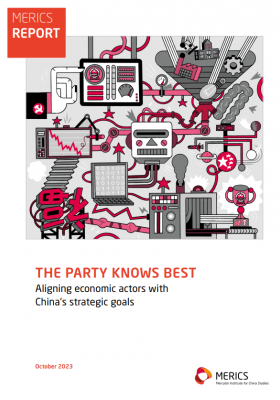

Managing Economic Cooperation and Competition with China
Towards a More Integrated European Trade Policy Approach
Nearly two decades after China acceded to the World Trade Organization (WTO), its compliance record and alignment of economic policies and trading practices with existing WTO rules remains contested. With the exception of the decision to join the Information Technology Agreement (ITA) taken under President Xi Jinping, there are few signs that Beijing intends to conform to existing or emerging regulatory regimes linked to the WTO, nor to engage in meaningful reforms of the international trading system. Doing so would counter and constrain key features of China’s state-led economy. The European Union (EU) has made laudable attempts to ‘comprehensively overhaul the WTO by 2022’. However, Europe must anticipate a future in which the WTO and other international frameworks only govern some aspects of its trade relationship with China.
As this analysis sets out, China will be a comprehensive, confident, but conflicted trade actor, which continues to deviate from WTO norms, while pushing the boundaries of traditional trade policy. This creates both opportunities and challenges for Europe. To manage them, the new Commission should live up to its ‘digital, green and geopolitical’ agenda in the realm of trade and, together with the EU member states, embrace an integrated trade policy approach vis-à-vis China that is comprehensive and confident, and is guided by the need to promote European competitiveness in global trade.
An integrated EU trade policy requires (1) in-depth awareness of China’s approach to trade policy and the factors driving it, (2) EU-wide cohesion on the trade policy approach pursued towards China across different dimensions, (3) institutional capacity for EU internal coordination on relevant trade policy, (4) sufficient depth of policy proposals to implement a more integrated trade policy approach, and (5) greater coordination of EU trade policy with Organisation for Economic Co-operation and Development (OECD) partners’ trade policies. While the EU already scores well on some of these criteria, improvements are needed in the most consequential areas of economic cooperation and competition with China. This analysis will highlight such areas and provide concrete recommendations for a more integrated EU trade policy.
Key findings:
- China will be a comprehensive, confident but internally conflicted trade actor that continues to deviate from WTO norms and pushes the boundaries of “traditional trade policy.” Beijing pursues an integrated trade policy approach and shows growing ambition in rule- and standard-setting. It is doubling down on regional and South-South trade partnerships and seeking to conquer new trade domains.
- China’s trade policy will prove challenging for Europe, given the persistent and distinct features of its domestic economic governance, coupled with internal and external pressures. Under President Xi Jinping, economic and trade policy is likely to be characterised by neo-mercantilist techno-nationalism and non-convergence with OECD countries.
- The EU has long sought to manage China-related concerns through negotiation, and multilateral or bilateral cooperative means, within reasonable timeframes. In an ideal scenario, the EU could call on a reformed WTO rulebook, jointly developed with China, and Beijing would quickly accede to existing WTO-associated plurilateral agreements. A strong EU-China bilateral investment agreement would lead to greater market opening, a more level playing field, transparency and effective disciplining of SOE behaviour. However, the EU’s ongoing efforts in these areas have yielded limited progress. More concerted measures will be necessary to push current negotiations forward.
- Europe needs to devise better-integrated trade policy to engage China, which is a trade actor that leverages and mixes traditional and non-traditional trade policy areas. An integrated EU trade policy needs to draw on trade-adjacent policy areas with the aim of (1) countering China’s distorted competition environment, and its consequences (2) pursuing competitive and sustainable connectivity (3) building leverage as a means to enforce “digital reciprocity” and data protection (4) securing equal access to China’s innovation system while ensuring the protection of IP and critical technologies in research cooperation.
- To successfully manage economic cooperation and competition with China, the EU institutions and member states should neither mimic China’s approach to integrated trade policy, nor give up their own liberal DNA. They should focus on (1) pursuing a set of targeted, issue-area specific policy priorities that respond to China’s trade profile while integrating the EU’s own approaches to the cross-cutting policy domains of standard setting, supply chain security and environmental and trade policies; (2) strengthening intra-European coordination and (3) capitalizing even more actively on the benefits of cooperating with OECD partners.





